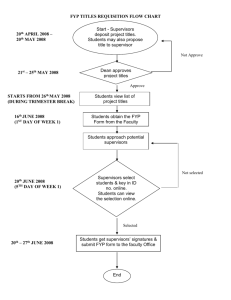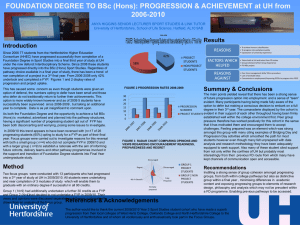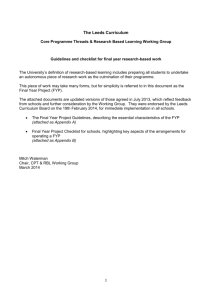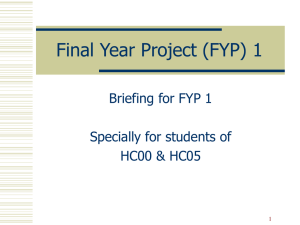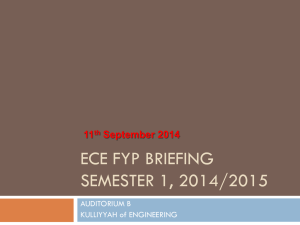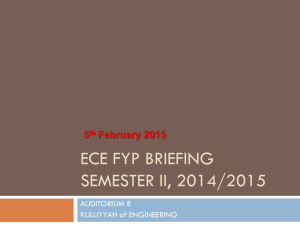FYP options for JH programmes - Leeds Curriculum
advertisement
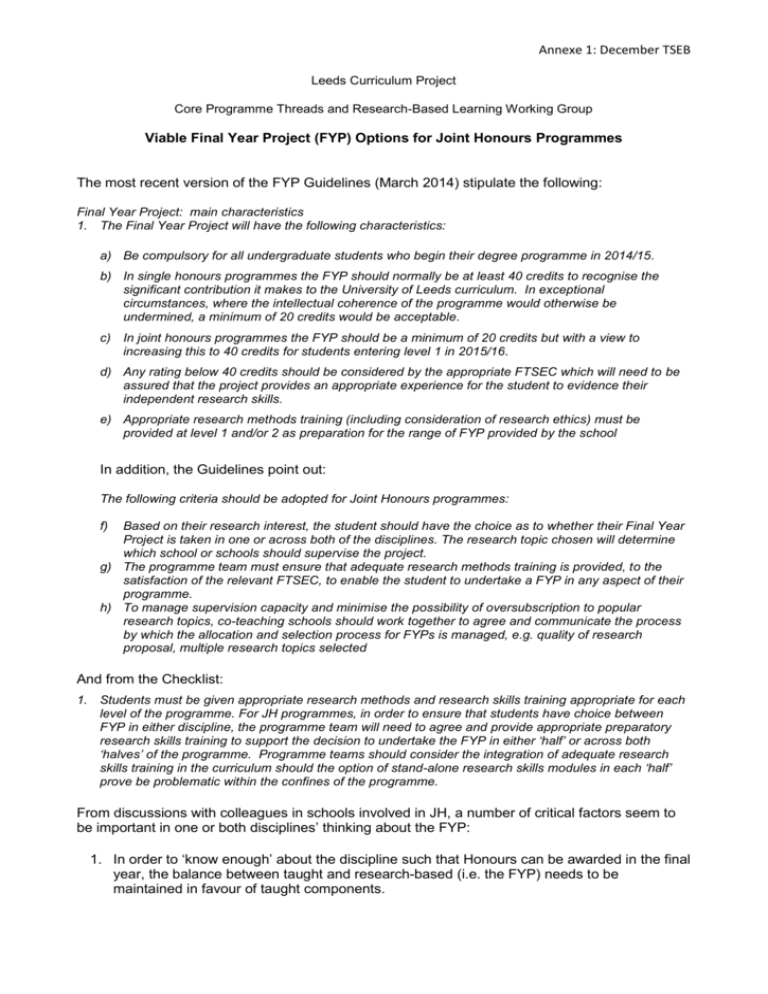
Annexe 1: December TSEB Leeds Curriculum Project Core Programme Threads and Research-Based Learning Working Group Viable Final Year Project (FYP) Options for Joint Honours Programmes The most recent version of the FYP Guidelines (March 2014) stipulate the following: Final Year Project: main characteristics 1. The Final Year Project will have the following characteristics: a) Be compulsory for all undergraduate students who begin their degree programme in 2014/15. b) In single honours programmes the FYP should normally be at least 40 credits to recognise the significant contribution it makes to the University of Leeds curriculum. In exceptional circumstances, where the intellectual coherence of the programme would otherwise be undermined, a minimum of 20 credits would be acceptable. c) In joint honours programmes the FYP should be a minimum of 20 credits but with a view to increasing this to 40 credits for students entering level 1 in 2015/16. d) Any rating below 40 credits should be considered by the appropriate FTSEC which will need to be assured that the project provides an appropriate experience for the student to evidence their independent research skills. e) Appropriate research methods training (including consideration of research ethics) must be provided at level 1 and/or 2 as preparation for the range of FYP provided by the school In addition, the Guidelines point out: The following criteria should be adopted for Joint Honours programmes: f) Based on their research interest, the student should have the choice as to whether their Final Year Project is taken in one or across both of the disciplines. The research topic chosen will determine which school or schools should supervise the project. g) The programme team must ensure that adequate research methods training is provided, to the satisfaction of the relevant FTSEC, to enable the student to undertake a FYP in any aspect of their programme. h) To manage supervision capacity and minimise the possibility of oversubscription to popular research topics, co-teaching schools should work together to agree and communicate the process by which the allocation and selection process for FYPs is managed, e.g. quality of research proposal, multiple research topics selected And from the Checklist: 1. Students must be given appropriate research methods and research skills training appropriate for each level of the programme. For JH programmes, in order to ensure that students have choice between FYP in either discipline, the programme team will need to agree and provide appropriate preparatory research skills training to support the decision to undertake the FYP in either ‘half’ or across both ‘halves’ of the programme. Programme teams should consider the integration of adequate research skills training in the curriculum should the option of stand-alone research skills modules in each ‘half’ prove be problematic within the confines of the programme. From discussions with colleagues in schools involved in JH, a number of critical factors seem to be important in one or both disciplines’ thinking about the FYP: 1. In order to ‘know enough’ about the discipline such that Honours can be awarded in the final year, the balance between taught and research-based (i.e. the FYP) needs to be maintained in favour of taught components. Annexe 1: December TSEB 2. Other programmes are comfortable with research activity (e.g. 40 credits) ‘counting’ towards Honours, and therefore are content to permit students to conduct more research and be exposed to less taught content. 3. The scope for truly interdisciplinary projects may, for the near term, be limited due in part to the lack of suitably qualified and interested supervisors. 4. Most parent and co-teaching schools seem to be conceptualising the JH FYP as a matter of a student choosing one discipline or the other for FYP, often in the form of a 20 credit project module in one or the other. 5. There are JH programmes which have historically permitted an imbalance between the two disciplines. 6. In some schools, with many JH programmes – co-taught with a number of other disciplines, it is the case that some would want a single model, whilst others (e.g. SMLC) would prefer to decide on the model, programme by programme. In this context, and prescription on the part of the Board applied to schools might actually undermine creativity and possibly interdisciplinarity within schools. 7. The Project Board has agreed that in principle, it is acceptable for a JH student to undertake two FYPs, as long as together they do not exceed half the credits for the final year. Critically, in such circumstances, the two teaching schools must discuss timing and assessment of the two projects. 8. The Project Board has also ruled that the maximum weighting acceptable for a JH FYP is half of the final year credits (NB there are some UG programmes, including integrated Masters where credit weighting of the year 4 project is more than half of the FY credits, for example 80 credits in the M.Biol programmes). RBL/CPT Group considerations Discussions within the RBL/CPT Group have been largely supportive of the proposals here, but members have expressed a number of concerns, including anxiety about students undertaking two FYPs (issues of time management, plagiarism, application of research methods). On balance, the Group seemed to feel that perhaps 2 x 20 credit FYPs, which were conceptually, and perhaps methodologically distinct might be viable. The Group also noted point 6 above, highlighting the difficulty in those schools with many JH programmes associated with bidisciplinary discussions. Some members of the group were also keen to permit exceptions, which is addressed below. Finally, the Group raised the issue of research methods training – and considerations with respect to its embedding within the FYP module, versus, and more progressive exposure, which might be more in line the our definition of research-based learning. Most members would support the latter, but for those disciplines where the FYP is new, members accepted that in order to facilitate its introduction, incorporating methods training as the first element of an FYP module, might be a productive approach. In order to meet the criteria established by the Project Board, the minimum standard for a JH programme which comprised 60 credits from each discipline in the final year, would be the requirement for a student to take either a 20 credit FYP module in one discipline or in the other. This preserves the student’s right to choose, whilst, potentially, allowing each discipline to maintain a sufficient volume of taught content such that honours in each discipline is warranted. Even if 20 credit FYP models are adopted, they must be designed to be recognisable as research in the discipline. The Board has agreed that our aspiration should be to privilege the Project module in some manner – the approach adopted being to additionally credit weight the Project, so as to single it out from other final year modules. This should remain the aspiration. The assumption here is that JH programmes will remain as Bachelors programmes for the time being; any development of a JH integrated Masters programme would require further discussion about the credit weighting acceptable for the FYP in such programmes. The Board has also confirmed that no more than 50% of credits in final year Bachelors programme should be dedicated to the FYP (NB for Annexe 1: December TSEB integrated Masters programmes the project component in the final year may contribute more than 50%). The options set out in the table below meet the Project’s requirements. Considerations which flow from choices are set out below the table. Model Minimum requirements (student chooses 1 OR 2) Privileged project in one Discipline (student chooses 1 OR 2) Double project (student chooses 1 AND 2) Interdisciplinary Project (student chooses a project which will be co-supervised and credits ‘shared’ between the schools). Discipline 1 Discipline 2 20 credit FYP 20 credit FYP 30 to 60 credit FYP 30 to 60 credit FYP 20 to 30 credit FYP 20 to 30 credit FYP 20 to 60 credit FYP It follows that there might be programme circumstances in which a JH student might be permitted to undertake a minimum requirement (20 credit) project in one discipline, and a ‘privileged’ Project (30 to 60 credits) in the other discipline. Though logically acceptable, the Board confirmed that no more than 50% of final year credits should be devoted to the FYP, which would limit the credit weight to 40 credits for the ‘privileged’ project. Though I have not sought comment from the RBL/CPT Group on this paper, it accommodates many comments made by Group members. On behalf of the Group, I believe that we would recommend to the Board that programmes wishing to permit double projects, particularly if together they exceed 50% of the credits for the level, should need to seek approval from the relevant Pro-Deans and possibly the Cross-Disciplinary Oversight Group, or some other monitoring agency. This may seem excessive, however the risks for the student associated with monitoring and supporting two projects, simultaneously, which must be independent, with levels of activity different between the two, are significant. We should recognise too though that there may be good grounds too for exceptions (e.g. more than 50% of the credits, linkages between projects in two disciplines) which might be considered by such a body. To rule such exceptions out, though pragmatically efficient, might be to undermine attempts to be creative with programme design; with that in mind, I suggest the Group would recommend the above table to be the generally accepted framework within which to operate, but with the caveat that exceptions might be permitted, which would need to be referred to some monitoring agency. Decision considerations: If a student is to have a fair choice, research methods training must be sufficiently strong in each discipline. If FYP modules are to be of larger weighting, learning outcome, supervision, and assessment regimes need to reflect the weight in a transparent manner. If a student is to opt for double project, the two disciplines must discuss relative timings and submission dates. Annexe 1: December TSEB The parent and co-teaching school will need to decide when in her/his candidature a student must select their preferred option (e.g. before end of the penultimate teaching year). Given the flexibility, it is essential that schools acknowledge the potential additional supervision requirement which might be necessary, and ideally attempt to anticipate this (perhaps again by asking students to indicate preferences well in advance of the start of the Project). Schools may try to rely on existing FYP structures, however, in order to accommodate Project requirements, schools may need to design FYP modules of lower or higher credit weighting. Ideally, parent and co-teaching schools should decide, collaboratively, on the preferred model; this decision should be made on pedagogic grounds. The over-arching imperative is that co-teaching and parent school MUST discuss how best to operationalise this key element of the Leeds Curriculum. In order to maintain the best student experience in each discipline and in the programme overall, this should NOT be a product of a parent school ‘deciding’ what will be best for the programme or student, given that we have agreed that JH students should be given the opportunity to decide where to position their project. Mitch Waterman, Chair, RBL/CPT Working Group Final version November 2014
